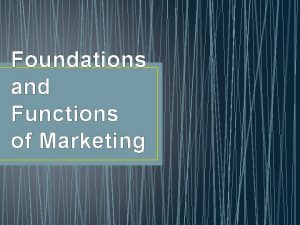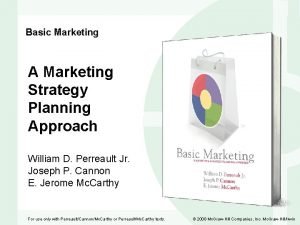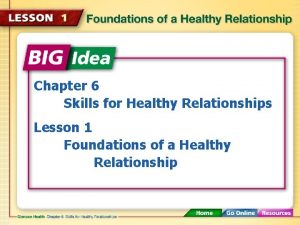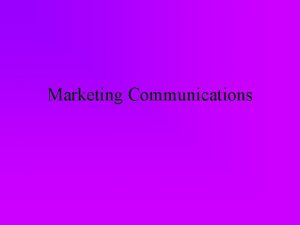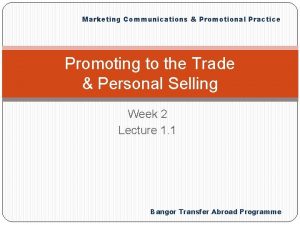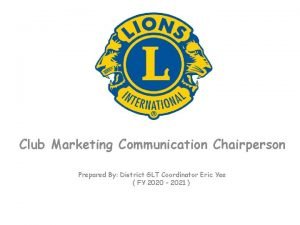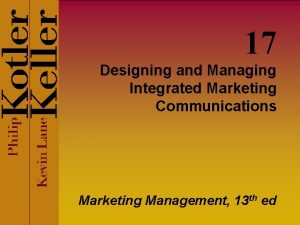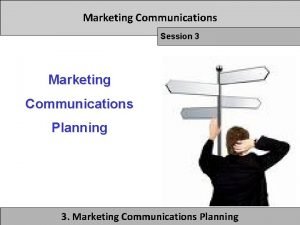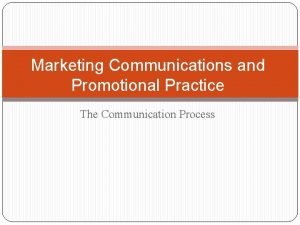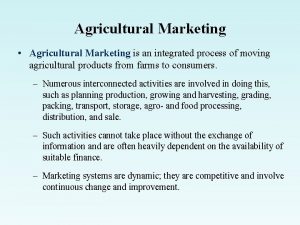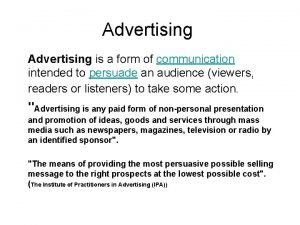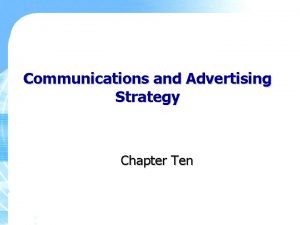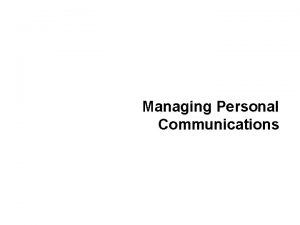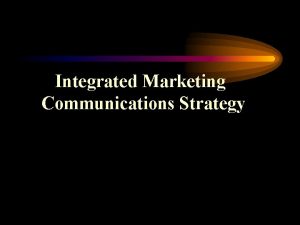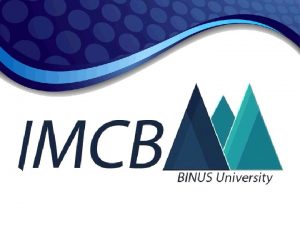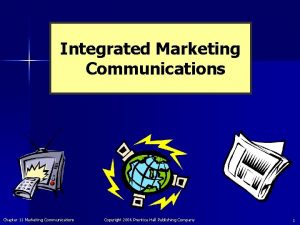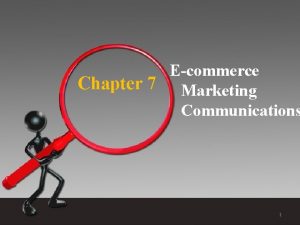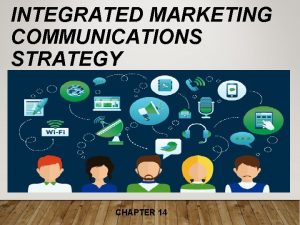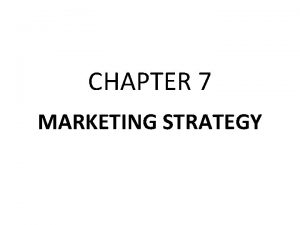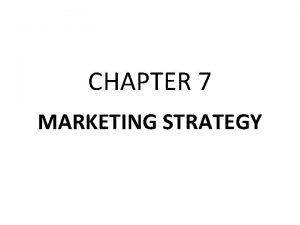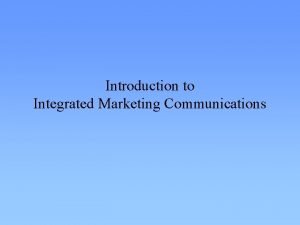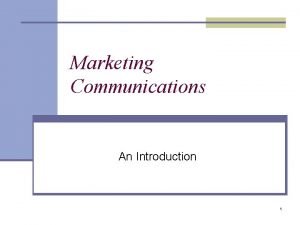foundations of MARKETING Marketing Communications Strategy Chapter 18


























- Slides: 26

foundations of MARKETING Marketing Communications Strategy Chapter 18

Marketing Communications Strategy Objectives Chapter 18 1. Explain the concept of the marketing communications mix. 2. Describe the marketing communications mix as part of the marketingmix. 3. Elaborate on the importance of the integrated marketing communications concept. 4. Outline a theoretical mode of the communications process. 5. Show various marketing communications must conform to this model in order to be effective. 6. Explain and contrast pulling and pushing marketing communications strategies. 7. Discuss the appropriateness of different types of marketing communications objectives. 8. Explain the concept of a marketing communications budget. 9. Discuss the appropriateness of different types of marketing communications budgets. 10. Discuss marketing communications in the light of some public criticisms. 18 -1

Marketing Communications Strategy Chapter 18 Marketing Communications • All activities and messages inform, persuade, and influence the consumer in making a purchase decision. 18 -2

Marketing Communications Strategy Figure 18. 1 Chapter Integrating the Marketing Communications Plan into the Total Marketing Mix Personal Selling Combined with Marketing Manager Sets goals & objectives Integrated marketing communications strategy Other aspects of the marketing program: Product Distribution Pricing strategy Nonpersonal Selling Feedback 18 -3 18 Produces Utility for Consumer

Marketing Communications Strategy Chapter 18 Integrated Marketing Communications (IMC) • A comprehensive marketing communications plan that takes into consideration all the communication disciplines being used and combines them to provide clarity, consistency, and maximum communications impact. 18 -4

Marketing Communications Strategy Figure 18. 3 Chapter 18 The Process of Marketing Communications Sender Marketing Manager Encoding Sales presentations, ads, displays, publicity, releases Transfer Mechanism Salesperson, print or electronic Advertising media, direct mail, internet, public relations channel Noise Feedback Advertising research, field reports, inventory movements 18 -5 Response Attitude change or decision Decoding Customer/receiver Interests message

Marketing Communications Strategy Chapter 18 Table 18. 1 Examples of Marketing Communications TYPE OF TRANSFER PROMOTION SENDER Personal employees Two-for-one message Television during the 18 -6 ENCODING DECODING BY MECHANISM RECEIVER RESPONSE FEEDBACK Canon Office Sales Canon sales Office manager Order placed Information that selling Equipment presentation representative and Canon copier for customers are on new model in local firm reacting positively office copier discuss Canon to the message sales presentation and those of competing suppliers Wendy's Coupon inserted Information that coupon(sales Hamburgers marketing purchased by customers are promotion) newspaper coupon for consumers using advertising hamburger agency and saves it Newspaper Hamburgers in weekend reader sees department and reacting positively the coupon to the Movie producer Advertisement Network Audience sees Small number Communication advertising for a new movie television ad but few of movie tickets failed to interest is developed by programs with decide to go to purchased and motivate the producer's high percentage the movie target market advertising of viewers in

Marketing Communications Strategy Chapter 18 Marketing Communications Mix • The blend of personal selling and nonpersonal communications (including advertising, sales promotion, public relations, sponsorship marketing, and point-of-purchase communications) by marketers in an attempt to accomplish information and persuasion objectives. 18 -7

Marketing Communications Strategy Figure 18. 4 Chapter 18 The Marketing and Marketing Communications Mix Marketing Mix Product Price Distribution Marketing communications 18 -8 Marketing Communications Mix Personal selling Nonpersonal selling • Advertising • Sales promotion • Point-of-purchase communications • Public relations • Sponsorship marketing • Publicity

Marketing Communications Strategy Chapter 18 Personal Selling • A seller’s promotional presentation conducted on a person-to-person basis with the buyer. 18 -9

Marketing Communications Strategy Chapter 18 Nonpersonal Communication (1 of 3) • Advertising Paid nonpersonal communication through various media by business firms, nonprofit organizations, and individuals who are in some way identified with the advertising message and who hope to inform or persuade members of a particular audience. 18 -10 a

Marketing Communications Strategy Chapter 18 Nonpersonal Communication (2 of 3) • Sales Promotion Those marketing activities, other than personal selling, mass media advertising, and publicity hat stimulate consumer purchasing and dealer effectiveness. • Public Relations A firm’s effort to create favourable attention and word-of-mouth. 18 -10 b

Marketing Communications Strategy Chapter 18 Nonpersonal Communication (3 of 3) • Sponsorship Marketing The practice of promoting the interests of a company by associating the company or a brand with a specific event. • Point-of-Purchase Communications Materials designed to influence buying decisions at the point of purchase. 18 -10 c

Marketing Communications Strategy Table 18. 2 18 Factors That Influence the Marketing Communications Mix FACTOR EMPHASIS ON Personal Selling Advertising Objectives of the Marketing Plan Affects all decisions in the mix Actions of Competitors Decide whether to match competitors and/or to develop a different mix Nature of the Market Number of buyers Geographic concentration Type of customer 18 -11 Chapter Limited number Concentrated Business purchaser Large number Dispersed Ultimate consumer Nature of the Product Complexity Service requirements Type of good Use of trade-ins Custom-made, complex Considerable Business Trade-ins common Standardized Minimal Consumer Trade-ins uncommon Stage in the Product Life Cycle Introductory and early growth stages Latter part of growth stage and maturity and early decline stages Price High unit value Low unit value Funds Available Affects all decisions in the mix

Marketing Communications Strategy Chapter 18 Pulling Strategy • A promotional effort by the seller to stimulate final-user demand, which then exerts pressure on the distribution channel. 18 -12

Marketing Communications Strategy Chapter 18 Pushing Strategy • The promotion of the product first to the members of the marketing channel, who then participate in its promotion to the final user. 18 -13

Marketing Communications Strategy Figure 18. 5 Chapter 18 Relative Importance of Advertising and Selling Relative Importance Selling Advertising Pre-transactional 18 -14 Transactional Post-Transactional

Marketing Communications Strategy Figure 18. 6 Chapter 18 Promotion Can Help Marketers Achieve Demand Objectives Price Demand objective for the product 2 Existing demand for a product 1 Quantity 18 -15

Marketing Communications Strategy Figure 18. 7 Product Differentiation Price Differentiated demand Homogeneous demand Quantity 18 -16 Chapter 18

Marketing Communications Strategy Figure 18. 8 Chapter 18 Promotion Can Accentuate the Value of the Product Price Less responsive to price differences More responsive to price differences D 2 Quantity 18 -17 D 1

Marketing Communications Strategy Figure 18. 9 18 Elements of Advertising Planning Research Inputs • Consumer research • Product research • Market analysis • Consumer situation Strategic Decisions • Setting objectives • Defining target markets • Determining advertising budget deciding media strategy • Coordinating with other marketing factors Tactical Execution • Establishing controls • Writing and producing ads and commercials • Selecting and scheduling media vehicles 18 -18 Chapter Feedback Taking into account constraints and uncontrollable influences Making evaluations and adjustments Measuring the effectiveness of advertising Market Impact

Marketing Communications Strategy Chapter 18 How Much Should be Spent on Marketing Communications? • Percentage of Sales • Fixed Sum per Unit • Meet Competition • Task-Objective Method 18 -19

Marketing Communications Strategy Chapter 18 Task-Objective Method • A sequential approach to allocating marketing communications budgets that involves two steps: 1)defining the realistic communication goals the firm wants the marketing communications mix to accomplish, and 2)determining the amount and type of marketing communications activity required to accomplish each of these objectives. 18 -20

Marketing Communications Strategy Chapter 18 Direct-Sales Results Test • A test that attempts to ascertain for each dollar of promotional outlay the corresponding increase in revenue. 18 -21

Marketing Communications Strategy Chapter 18 The Value of Marketing Communications • Business and Nonprofit Enterprise Importance • Economic Importance • Social Importance 18 -22

foundations of MARKETING Chapter Thank you for using our slides! Logon ‘www. tactguys. com’ & enjoy more and more…
 Economic foundations of strategy
Economic foundations of strategy Communications strategy in kc
Communications strategy in kc 4 foundations of marketing
4 foundations of marketing Universal functions of marketing
Universal functions of marketing Chapter 6 lesson 1 foundations of a healthy relationship
Chapter 6 lesson 1 foundations of a healthy relationship Chapter 6 lesson 1 foundations of a healthy relationship
Chapter 6 lesson 1 foundations of a healthy relationship Describe the care team and the chain of command
Describe the care team and the chain of command Chapter 2 foundations of individual behavior
Chapter 2 foundations of individual behavior Chapter 1: foundations of government
Chapter 1: foundations of government Chapter 4 foundations background to american history
Chapter 4 foundations background to american history Foundations in personal finance chapter 1 summary answers
Foundations in personal finance chapter 1 summary answers Chapter 1 foundations of government vocabulary
Chapter 1 foundations of government vocabulary Chapter 1: foundations of government pdf
Chapter 1: foundations of government pdf Foundations of government (chapter 1 test form a)
Foundations of government (chapter 1 test form a) Sender encoding message decoding receiver
Sender encoding message decoding receiver Push pull profile strategies marketing communications
Push pull profile strategies marketing communications Integrated marketing communications definition
Integrated marketing communications definition Global marketing and communications
Global marketing and communications Club marketing communications chairperson
Club marketing communications chairperson Designing and managing integrated marketing communications
Designing and managing integrated marketing communications Push and pull strategy
Push and pull strategy Drip elements of marketing communications
Drip elements of marketing communications K state communications and marketing
K state communications and marketing Agricultural marketing process
Agricultural marketing process Rabostic
Rabostic Coca cola imc
Coca cola imc Traditional communication model
Traditional communication model


